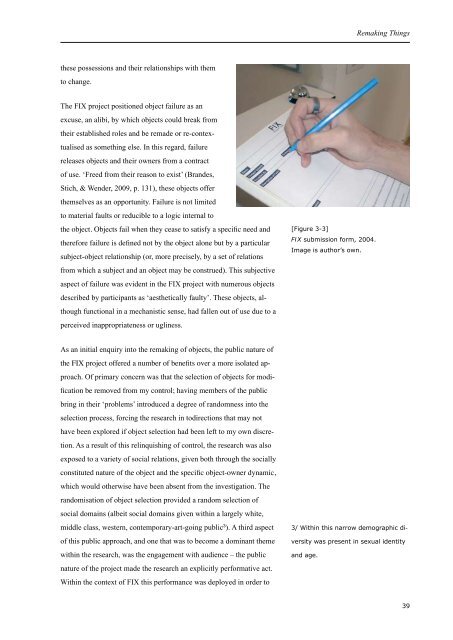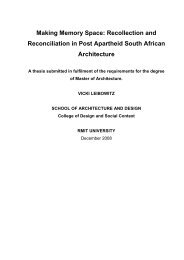Objects in Flux - RMIT Research Repository - RMIT University
Objects in Flux - RMIT Research Repository - RMIT University
Objects in Flux - RMIT Research Repository - RMIT University
Create successful ePaper yourself
Turn your PDF publications into a flip-book with our unique Google optimized e-Paper software.
these possessions and their relationships with them<br />
to change.<br />
The FIX project positioned object failure as an<br />
excuse, an alibi, by which objects could break from<br />
their established roles and be remade or re-contextualised<br />
as someth<strong>in</strong>g else. In this regard, failure<br />
releases objects and their owners from a contract<br />
of use. ‘Freed from their reason to exist’ (Brandes,<br />
Stich, & Wender, 2009, p. 131), these objects offer<br />
themselves as an opportunity. Failure is not limited<br />
to material faults or reducible to a logic <strong>in</strong>ternal to<br />
the object. <strong>Objects</strong> fail when they cease to satisfy a specific need and<br />
therefore failure is def<strong>in</strong>ed not by the object alone but by a particular<br />
subject-object relationship (or, more precisely, by a set of relations<br />
from which a subject and an object may be construed). This subjective<br />
aspect of failure was evident <strong>in</strong> the FIX project with numerous objects<br />
described by participants as ‘aesthetically faulty’. These objects, although<br />
functional <strong>in</strong> a mechanistic sense, had fallen out of use due to a<br />
perceived <strong>in</strong>appropriateness or ugl<strong>in</strong>ess.<br />
As an <strong>in</strong>itial enquiry <strong>in</strong>to the remak<strong>in</strong>g of objects, the public nature of<br />
the FIX project offered a number of benefits over a more isolated approach.<br />
Of primary concern was that the selection of objects for modification<br />
be removed from my control; hav<strong>in</strong>g members of the public<br />
br<strong>in</strong>g <strong>in</strong> their ‘problems’ <strong>in</strong>troduced a degree of randomness <strong>in</strong>to the<br />
selection process, forc<strong>in</strong>g the research <strong>in</strong> todirections that may not<br />
have been explored if object selection had been left to my own discretion.<br />
As a result of this rel<strong>in</strong>quish<strong>in</strong>g of control, the research was also<br />
exposed to a variety of social relations, given both through the socially<br />
constituted nature of the object and the specific object-owner dynamic,<br />
which would otherwise have been absent from the <strong>in</strong>vestigation. The<br />
randomisation of object selection provided a random selection of<br />
social doma<strong>in</strong>s (albeit social doma<strong>in</strong>s given with<strong>in</strong> a largely white,<br />
middle class, western, contemporary-art-go<strong>in</strong>g public3 ). A third aspect<br />
of this public approach, and one that was to become a dom<strong>in</strong>ant theme<br />
with<strong>in</strong> the research, was the engagement with audience – the public<br />
nature of the project made the research an explicitly performative act.<br />
With<strong>in</strong> the context of FIX this performance was deployed <strong>in</strong> order to<br />
[Figure 3-3]<br />
FIX submission form, 2004.<br />
Image is author’s own.<br />
Remak<strong>in</strong>g Th<strong>in</strong>gs<br />
3/ With<strong>in</strong> this narrow demographic di-<br />
versity was present <strong>in</strong> sexual identity<br />
and age.<br />
39
















